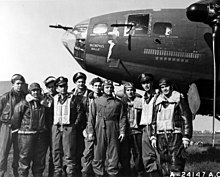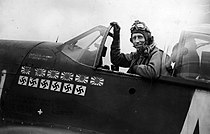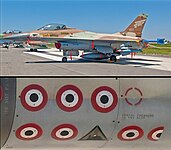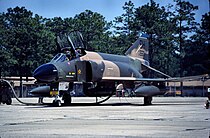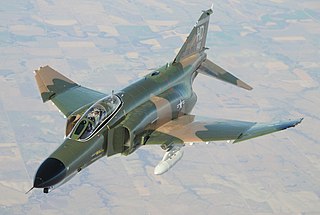
The McDonnell Douglas F-4 Phantom II is an American tandem two-seat, twin-engine, all-weather, long-range supersonic jet interceptor and fighter-bomber originally developed by McDonnell Aircraft for the United States Navy. Proving highly adaptable, it entered service with the Navy in 1961 before it was adopted by the United States Marine Corps and the United States Air Force, and by the mid-1960s it had become a major part of their air arms. Phantom production ran from 1958 to 1981 with a total of 5,195 aircraft built, making it the most produced American supersonic military aircraft in history, and cementing its position as a signature combat aircraft of the Cold War.

The Mikoyan-Gurevich MiG-21 is a supersonic jet fighter and interceptor aircraft, designed by the Mikoyan-Gurevich Design Bureau in the Soviet Union. Its nicknames include: "balalaika", because its planform resembles the stringed musical instrument of the same name; "Ołówek", Polish for "pencil", due to the shape of its fuselage, and "Én Bạc", meaning "silver swallow", in Vietnamese.
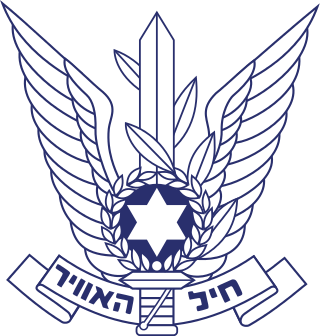
The Israeli Air Force operates as the aerial and space warfare branch of the Israel Defense Forces (IDF). It was founded on May 28, 1948, shortly after the Israeli Declaration of Independence. As of April 2022, Aluf Tomer Bar has been serving as the Air Force commander.

The War of Attrition involved fighting between Israel and Egypt, Jordan, the Palestine Liberation Organisation (PLO) and their allies from 1967 to 1970.
This is a list of aviation-related events from 1982.
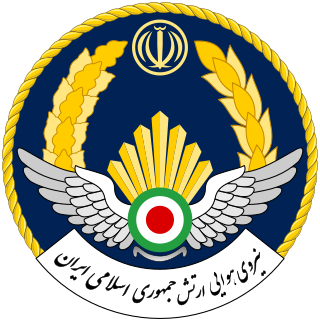
The Islamic Republic of Iran Air Force is the aviation and space branch of the Islamic Republic of Iran Army. The present air force came into being when the Imperial Iranian Air Force was renamed in 1979 following the Iranian Revolution. The IRIAF was heavily involved in the Iran–Iraq War, carrying out major operations like Operation Kaman 99, Operation Sultan 10, the H-3 airstrike, and the first attack on a nuclear reactor in history, Operation Scorch Sword. As a result of eight years of aerial combat in that conflict, the IRIAF has the second highest claimed number of fighter aces in the region, exceeded only by the Israeli Air Force; as many as seven IRIAF pilots claimed more than six kills, mostly achieved in the F-14 Tomcat. Veterans of the Iran–Iraq War would go on to form the core of the IRIAF command.

Nose art is a decorative painting or design on the fuselage of an aircraft, usually on the front fuselage.
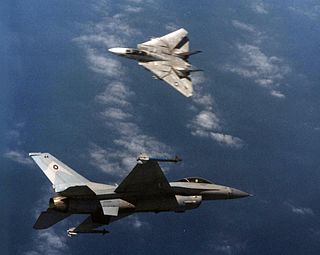
A dogfight, or dog fight, is an aerial battle between fighter aircraft conducted at close range. Modern terminology for air-to-air combat is air combat manoeuvring (ACM), which refers to tactical situations requiring the use of individual basic fighter maneuvers (BFM) to attack or evade one or more opponents. This differs from aerial warfare, which deals with the strategy involved in planning and executing various missions.

A flying ace, fighter ace or air ace is a military aviator credited with shooting down five or more enemy aircraft during aerial combat. The exact number of aerial victories required to officially qualify as an ace is varied, but is usually considered to be five or more.

Aerial supremacy is the degree to which a side in a conflict holds control of air power over opposing forces. There are levels of control of the air in aerial warfare. Control of the air is the aerial equivalent of command of the sea.
This is a list of aviation-related events from 1991.

The German Air Force is the aerial warfare branch of the Bundeswehr, the armed forces of Germany. The German Air Force was founded in 1956 during the era of the Cold War as the aerial warfare branch of the armed forces of West Germany. After the reunification of West and East Germany in 1990, it integrated parts of the air force of the former German Democratic Republic, which itself had been founded in 1956 as part of the National People's Army. There is no organizational continuity between the current German Air Force and the former Luftwaffe of the Wehrmacht founded in 1935, which was completely disbanded in 1945/46 after World War II. The term Luftwaffe that is used for both the historic and the current German air force is the German-language generic designation of any air force.

Gun cameras are cameras mounted on a gun, used to photograph or record from its perspective. They are typically used on the weapons of military aircraft and operate either when the gun is fired or at the operator's will. Gun cameras are used for training, analysis, or documentation purposes.
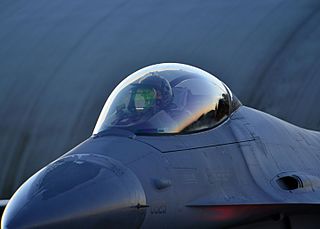
A bubble canopy is an aircraft canopy constructed without bracing, for the purpose of providing a wider unobstructed field of view to the pilot, often providing 360° all-round visibility.

Air-to-air combat is the engagement of combat aircraft in warfare in which primarily fixed-wing aircraft attempt to destroy enemy aircraft using guns, rockets and missiles. The Korean War saw the greatest amount of air-to-air combat since World War II. During the war the United States claimed to have shot down around 700 fighters. After the war the U.S. Air Force reviewed its figures in an investigation code-named Sabre Measure Charlie and downgraded the kill ratio of the North American F-86 Sabre against the Mikoyan-Gurevich MiG-15 by half from 14:1 to 7:1. One of the factors inflating US numbers was that most dogfights took place over enemy-controlled area. The only way to confirm kills was through gun camera photography. USAF pilots were credited with a kill if the gun camera showed their guns striking the enemy aircraft even if no one actually saw it go down. However, Soviet Air Force kill claims were also highly exaggerated, based upon inherent flaws in their film grading procedures. For instance, the S-13 gun camera was not aligned with either the gunsight or either cannons' ballistics. It ran only while the firing buttons were depressed. Film graders commonly included unit commanders and political commisars who would confirm a "kill"—sometimes even if one had not been claimed by a pilot—when the camera's crosshairs touched the target for two movie frames. During the first 16 months of combat Soviet V-VS units claimed 218 F-86s destroyed when only 36 had been lost. This results in a 600 per cent inflation rate in victory credits over actual Sabres destroyed. However, these figures are complicated by the fact that the Americans routinely attributed combat losses to landing accidents and other causes.
The General Dynamics F-16 Fighting Falcon has served the United States and the air arms of 25 other nations. Over 4,400 F-16s have been sold.

The 332d Expeditionary Operations Group is a provisional air expeditionary group of the United States Air Force's Air Combat Command, currently active. It was deactivated on 8 May 2012 and reactivated 16 November 2014.

Netz 107 is a General Dynamics F-16A block 10 Fighting Falcon of the Israeli Air Force, tail number 107. Netz 107 participated in Operation Opera, bombing the Osiraq nuclear reactor, and was later credited with 6.5 enemy aircraft kills, a world record number of kills for an F-16.
